Is your reef tank covered with unwanted algae? Do you want to know how to get rid of them and bring back the balance? Well, I know how disturbing it is to find your reef tank aquarium with excessive amounts of troublesome algae.
There are a variety of nuisance algae such as green hair algae, bubble algae, brown diatom algae, red slime algae, and many more. Dealing with these algae to establish the natural ecosystem back in the tank is one of the most important things you should do as a reefer or saltwater aquarist.
Removing algae by hand or filtration, adjusting the light intensity, reducing phosphate and nitrates, using RO/DI water, maintaining the proper water flow, removing the excess nutrients, and adding natural algae eaters are some of the effective ways to get rid of algae in a reef tank.
In this article, I am going to talk about these ways in detail after letting you know the common causes of algae growth in a reef tank. I will also discuss specific types of reef tank algae and how you can get rid of them. Waiting no more, let’s dive in.
What Are The Causes Of Algae In The Reef Tank?
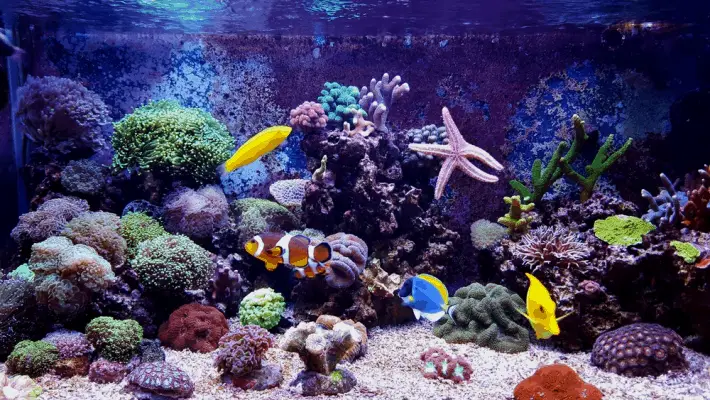
Do you know the causes of algae growth in the reef tank aquarium? Well, there are many reasons why algae can create a home in your reef tank. Here are some of them:
1. Light Intensity and Quality:
Some algae such as green algae grow when the intensity of the light is very high. On the contrary, brown algae and some other types may grow when the lighting intensity is low. Bad quality light can also promote the algae to grow.
2. Excess Nutrients:
High amounts of nutrients or dissolved organic compounds in the tank water inspire the algae growth. It is because algae live on these nutrients.
3. High Level of Nitrates and Phosphates:
Nitrate and Phosphate are two key elements that let the algae thrive. Most of the algae are supported by the nitrate and phosphate to grow.
4. Poor Tank Maintenance:
In case an aquarist does not take care of his tank properly such as changing the water regularly and maintaining the balance of the nutrients level, and keeping the phosphate and nitrates in check, the tank becomes a breeding ground for the algae.
5. Improper Water Supply or Flow:
Some algae are more likely to grow at those parts of the tank where the water flow or circulation is low. On the other hand, there are some algae such as hair algae or filamentous species that grow more in high flow areas.
6. Low-Quality Sea Salt Mix:
Poor quality sea salt mix usage increases the risk of higher algae growth as they contain more phosphates and nitrates along with other harmful elements.
7. Absence of Algae Eaters:
Algae eaters or natural cleaning crew help to keep the algae in control by consuming the most of them. The absence of algae eaters causes the algae to grow quicker.
8. Improper Water Source:
If you use tap water in the reef tank, the possibility is that you are inspiring the algae. Tap water comes with a higher level of phosphates, nitrates, and other unwanted materials.
Keep in mind that all the algae affect the reef tank ecosystem negatively. Macroalgae cultivation is common for the reef tank and is beneficial to remove the nitrates and phosphates from the tank water.
A little amount of algae in a reef tank does not pose much threat to the tank inhabitants. However, problems occur when they cover the entire tank and go out of control.
If you are having issues with the unwanted algae and get rid of them, you can follow the suggestions I am going to share with you in the upcoming sections.
13 Common Ways to Control Algae in a Reef Tank
I will discuss some specific ways to get rid of different types of reef tank algae in the latter part of this article.
But, there are some common techniques that you can adopt for almost all types of algae in the reef tank. Let’s have a look at some common approaches to follow if you want to get rid of a variety of algae in the reef tank:
1. Adjust the Light Intensity
Many algae grow due to the excess amount of light in the aquarium. However, the opposite is also applicable to a few algae.
No matter whether the excess of light or too little of it is creating the problem, adjusting the light as required is the best solution to deal with this issue.
Make sure that you are not using the light in the tank for a longer period than required. Prolonged use of high-intensity lighting increases CO2 and nutrients in the water to let the algae grow.
So, what’s the standard amount of lighting for your reef tank that does not help the speedy growth of algae?
Well, it depends a lot on the tank size. Ideally, you can keep the light on for about 8 to 10 hours. However, it is also fine to give 6 to 8 hours of lighting if the tank is exposed to natural light.
Arrange the lighting as per the demand of the tank creatures. Do not add additional light to make the tank look more enlightened.
Keeping the brightness level soft helps the fishes and corals grow without letting the algae thrive. I talked about how much LED light is required for a reef tank in this article.
2. Upgrade the Lighting Type and Quality
Fluorescent lights have a connection with algae problems. In this kind of light, both the quantity and the quality diminish over time. Most of the nuisance algae grow when the tank is not supplied with high-quality lights.
If you are using fluorescent lights, you should replace the bulbs once to twice per year. However, I would suggest you consider setting LED fixtures instead of the fluorescent bulbs to get the best result when fighting against the nuisance algae.
The reasons why you should switch to LED fixtures in the reef tank include better efficiency, low electricity bills, low heat, longer durability, etc.
3. Introduce Algae Eaters Inside the Tank
Brining algae-eating inhabitants in your reef tank can help you to remove the algae to a great extent. Hermit crabs, emerald crabs, fox-face, tail spot blenny, chevron tang, chestnut cowries, and Mexican turbo snails are some of the common saltwater algae eaters you can adopt in your reef tank.
4. Consider Frequent Water Changes
When did you last change the water? Is it more than a week? If yes, it can be one of the reasons why your reef tank is dominated by algae.
If you do not change the water at least once a week, the level of phosphates and nitrates grow and thus creates a favorable environment for algae.
Proper maintenance of the reef tank includes keeping the tank clean and tidy. If you clean the tank after a certain period, you will have fewer nutrients, less dissolved materials, and no suspended particles.
However, when you change the water, use the right source. Do not use tap water that contains high levels of CO2, nitrates, and phosphates. Instead, use RO/DI water that comes with the standard amount of nutrients level.
Make sure that the water you are using to replace the old water is properly filtered so that any contamination cannot affect the fishes and corals.
5. Control the CO2 Level
More CO2 in the tank means more algae. So, make sure that your tank comes with a standard level of CO2 and the level is not so high. You need to be very cautious while using calcium reactors in your reef tank.
6. Decrease the Nutrients
Adding excessive nutrients offer more nitrates and phosphates that increase algae growth. As algae feed on them, excess nutrients will help to grow more algae.
Protein skimmers can help your reef tank in this respect. They are capable of physically removing the organic substances that are rich in nutrients.
Apart from this, they can also help to particulate the substances before getting decomposed and releasing phosphates, nitrates, and other nutrients in the tank water.
You can also use phosphate-removing filter media to control the amounts of nutrients your tank ultimately receives. Granular Ferric Oxide or GFO is capable enough to absorb phosphate from the water to a great extent. If your tank does not get much phosphate to let the algae live, the algae starve and eventually die.
If you are using GFO in your reef tank, you have to keep in mind to replace them every 2 to 3 months so that the phosphate level remains low.
Reducing the nutrients level in the saltwater tank is one of the safest ways to control algae growth.
7. Put the Right Plants
Putting wrong plants that are not meant to be in your reef tank increases the risk of nuisance algae. You must be choosy while you pick plants for your tank.
Some of the saltwater plants suitable for your tank include Halimeda, Mermaid’s Fan, Turtle Grass Shoots, Red Mangrove Propagule, etc. More suitable plants in the tank translate into fewer nuisance algae.
8. No Overfeeding or Underfeeding
Maintaining the balance of food in the reef tank is a very important step to eliminate algae growth. Overfeeding the fishes contributes to creating more phosphate and along with polluting the tank water with toxic ammonia.
However, underfeeding the fishes too is not a good idea. What you need to make sure is that the fishes get as much food as they require to stay healthy. Do not supply less or more food than required. Supplying more food will invite nuisance algae and supplying too little will lead to the death of the fishes due to starvation.
9. Clean or Cut the Algae Down
You can clean the algae from your tank by hand or ripping them manually if possible. You can also use a filtration process. However, ripping the algae is a good way when the tank is overburdened with too many algae.
Before you go to clean the algae from the glass, wall, surface, and the rocks of your reef tank, make sure that you are using rubber gloves in your hand.
10. Reduce Silicates
Make use of live sand, gravel, or other appropriate substrate elements to reduce the silicates from the tank. Using the aragonite types of substrates is the best to get this task done.
11. Good Quality Sea Salt Mix
Do not use average or low-quality sea salt mix if you want to get rid of algae. Rather, choose a sea salt mix that does not compromise with the quality. You have to be careful when you choose carbon. It can also be responsible to bring about unwanted materials in the tank.
12. Regulate the Water Flow
Make sure that all the parts of the tank get the appropriate water flow. However, when dealing with algae, you have to be tactful about the amount of water flow. It is because, while some algae thrive in low water flow, some may thrive in high water flow as well. You can use wave makers to control the water flow.
13. Use Additives or Commercial Products
If none of the methods mentioned come to your help, you can try additives and other anti-algae products to fight with the algae in the reef tank. Algaecides is one of the common products many reef tank users use as their last resort while working with excessive amounts of nuisance algae.
17 Types of Nuisance Algae and How to Get Rid of Them from Reef Tank
Well, now that you know the common ways to get rid of algae, it is time to be more specific. In this section of the article, I am going to share the ways you should adopt to remove or starve out specific types of reef tank algae. Let’s go ahead.
1. Green Hair Algae
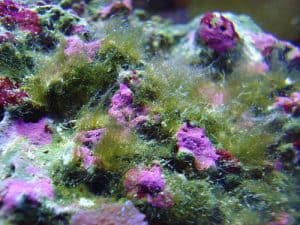
Though green hair algae have hundreds of filamentous green algae species, they come in simple and fine texture. You can easily trace them with some easily distinguishable features.
Despite you cannot see them without a microscope when they are scattered, it is easy to identify them when they make groups.
They are not very coarse as many other algae groups. You can easily pull and pluck them. Once you remove them from the water, they lose their form.
Iron and potassium in the reef tank and excessive amounts of nutrients such as nitrates and phosphates are two of the main causes of green hair algae.
How to Get Rid of Green Hair Algae from Reef Tank?
- Change the tank water once a week
- Remove them by hand or filtration.
- Maintain proper alkalinity and magnesium level.
- Employ algae green algae eaters like Emerald Crabs, Conchs, Florida Ceriths, Assorted Hermits, Urchins, Blue Legs, etc.
- Siphon out the algae as much as possible.
- Use high quality and updated fluorescent lights or LED fixtures.
- Add a Phosban reactor.
- Bring microalgae like Chaeto.
2. Green Turf Algae

Green turf algae are different species of green-colored algae with certain characteristics in common. Unlike green hair algae, these are wiry and coarse. It is really difficult to pluck them if they sprout from the rock.
They have thicker and wider blades. Some of these algae feature a mat-like root structure. Once you discover green turn algae, it is wise to treat them outside the tank.
How to Get Rid of Green Turf Algae from Reef Tank?
- Take the affected rock or fag out and treat them by dipping into the water that contains algaecide.
- Emerald Crabs, Chitons, and Urchins are three of the effective green turf algae-eating inhabitants. Adopt them in the tank.
- If the green turf algae in your reef tank feature a root mat, you can peel them by pushing down on the algae. It works best when the algae become quite mature.
3. Bryopsis Pennata and B. Plumosa
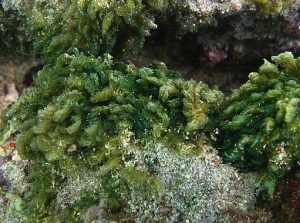
These are some of the most stubborn macroalgae found in the reef tank aquariums. With visible midribs, Bryopsis pennata and B. plumosa have narrower branches. They feature a root system on the rocks that look like a mat.
Bryopsis pennata comes with sparse and irregular branches while its cousin B. plumosa features full and symmetrical branches. Though many reef tank owners confuse green hair algae with these species, these are completely from different species.
These algae are hated by the reef tank owners due to their clingy nature. It is not easy to get rid of them once they attack your reef tank.
How to Get Rid of Bryopsis pennata and B. plumosa Algae from Reef Tank?
- Add Nudibranchs, Sea Hares, Urchins, Chitons, Emerald crabs, and Astraea tubers in the reef tank. However, due to the stubbornness of these algae, algae eaters are not highly effective against them.
- When you get to know that your tank is affected by Bryopsis pennata or B. plumosa, you have to be quick to act. If only one or two rocks are affected, take them away, remove the algae, and then put them inside a quarantine tank without light.
- Though many people do not recommend removing the Bryopsis by hands due to the risk of quick-spreading, I will tell you otherwise. Remove them as much as possible by your hand.
It is because untreated Bryopsis can spread quicker than the ones left after the removal process.
However, it is best to remove the rock first and then clean the algae out of the tank.
- Reduce the nutrients level as low as possible to starve the algae out. If you do so, it will be tough for them to hold strong for long or come back after manual removal.
- If the above-mentioned methods do not work, you can raise your magnesium level to very high.
Though many aquarists got success with this method, you should refrain from adopting this without proper research so that it does not cause any losses in your reef tank. I am not responsible if you make a mess.
4. Diatoms
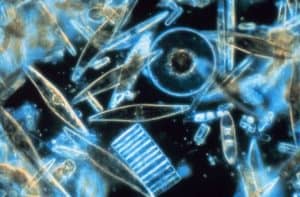
If you have just set a tank system, diatoms are the first uninvited guests you need to deal with. They are very abundant on the earth and in aquarium surfaces. They look like brown powder and appear usually after one or two weeks of a tank cycle.
As they live on silicates, they appear when you bring about new rock, sand, or introduce any plastic substance in the tank.
How to Get Rid of Diatoms from Reef Tank?
- Use a mag float to wipe the diatoms from the glass.
- A turkey baster and toothbrush can help clean them from the other parts of the tank.
- Nerites, Astraea snails, Trochus, and Ceriths are some of the clean-up crew you can take help from to get rid of diatoms from your reef tank.
- When the silicates in the tank decrease, other algae species can also replace diatoms.
5. Red Slime/Cyano/Cyanobacteria
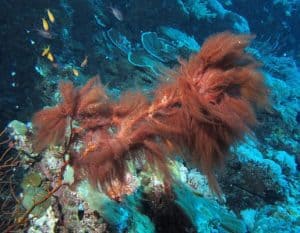
Cyano, Red Slime, or Cyanobacteria are the combination of bacteria and the algae. You will have to face them at least once in your reef tank as they are very common. Cyanobacteria have a lot of color variations including red.
When it comes to the causes of red slime or cyano, nutrients especially phosphates and iron are the main triggers. They mostly prefer to grow at a low flow zone of the tank.
The situation worsens if the water is warmer due to the excess lighting.
Low alkalinity is another reason that encourages the growth of cyano in the reef tank.
And finally, tap water fuels the red slime outbreak rapidly.
How to Get Rid of Red Slime/Cyano/Cyanobacteria from Reef Tank?
- Replace the tap water with RO/DI water. Change the water at least once a week.
- Make sure that the water flows adequately to all the parts of the tank.
- Control the lighting intensity to keep the water cold.
- Increase the alkalinity level in the water and decrease the phosphates and nitrates level to the desired level.
- Avoid feeding phosphate-rich foods like seasoned nori and other low-quality phosphate-enriched foods as long as the cyano outbreak is not under control.
- Use a mag float, hard corals and rocks, light toothbrush, etc. to wipe the glass off.
- You can pull the cyano off if they are on the sand.
- If you are using a toothbrush to dislodge the cyano, use a net or siphon to remove them from the water.
- Keep in mind that the cyano can come back if the balance of nutrients is not maintained properly.
6. Green Film Algae
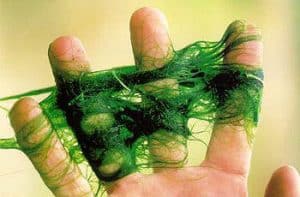
Tanks of all ages may have a green, cloudy film of algae in it. They remain more or less in the tank all the time. Though you might not notice them all the time, green film algae are easily recognizable when they start blooming together.
They create a cloudy and dense appearance in the reef tank.
How to Get Rid of Green Film Algae from Reef Tank?
- Copepods, Isopods, Amphipods are some good green film algae eaters on the earth. You can also try Nerites, Astraea, Chitons, and many species of limpets. Though many aquarists choose Hermit crabs, they are not so effective when it comes to fighting against green film algae.
- To remove excess phosphates in your reef tank and thus starve out the green film algae, you can make use of a Phosban reactor or granulated ferric oxide (GFO).
- Do not overfeed. Also, refrain from supplying phosphate-rich foods until the green film algae outbreak is under control.
- Use a mag float to clean them from the glass. A toothbrush is a good option for cleaning the rocks. Take a turkey baster to blast the rocks. And when you are all done, change the tank water.
7. Valonia/Bubble Algae
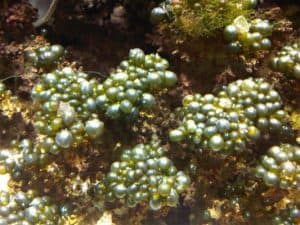
Coming from the Valonia genus, these algae can cover the whole tank within a short period. They start affecting just a few plants at the beginning and later on spread rapidly.
That’s why it is very important to treat these algae as soon as possible to stop promoting their further growth in the tank.
How to Get Rid of Valonia/Bubble Algae from Reef Tank?
- Remove every fragment of these algae from the rock if you want to prevent them from recurrence. Catch all the dislodged pieces that come out from the rocks. You have to be aggressive while following up on this process.
- Ruby Crabs, Emerald Crabs, and other kinds of Mithrax Crabs are good at eating bubble algae from the water.
- Inspect the frags and rocks of the tank regularly to know whether your tank is affected by bubble algae or not.
8. Lobophora
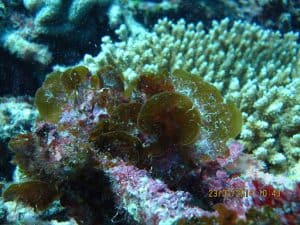
Lobophora algae are brown and slippery macro algae species. They are semi-rigid and rubbery in appearance. Many aquarists can not identify them properly and end up confusing these algae with plating coralline.
Lobophora algae vary a lot when it comes to color and form. They might have shapes like ruffled ribbons and sometimes like saucers. Similarly, they can be yellow or red. One good thing about Lobophora algae is that they do not spread from one rock to another too fast.
How to Get Rid of Lobophora Algae from Reef Tank?
- Quarantine the rock in a dark tank for an extended period.
- Make use of Chitons, Turbos, Tangs, Limpets, Urchins, Emerald Crabs, and Sea Hares are some of the effective Lobophora eating inhabitants. Though they can’t stop the aggression of algae completely, they can help to keep the algae in control.
9. Lyngbya
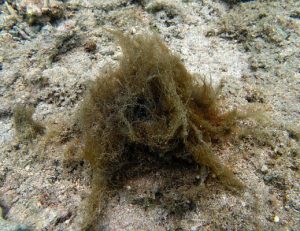
Being filamentous, Lyngbya is one of the species of cyanobacteria. Though many people confuse Lyngbya with hair algae, these are different from hair algae in many aspects.
Lyngbya algae are not slimy. Usually, they appear as reddish-brown in the tank. You can dislodge these quite effortlessly from the rocks. They do not have any mat structure or root.
But, still, they grow very fast and can cover the tank quicker than you think. Their growth speed accelerates when they are attached to a powerhead or if they get warm water in the tank.
How to Get Rid of Lyngbya from Reef Tank?
- Use a toothbrush to remove Lyngbya from the glass and rocks.
- Make use of the net to catch the floating parts.
- Ceriths, Blue Legs, Nerites, and Ragged Sea Hares are effective eaters to keep the Lyngbya in check.
- You can also follow the removal process of the red slime algae.
10. Gelidium/Red Wiry Turf Algae
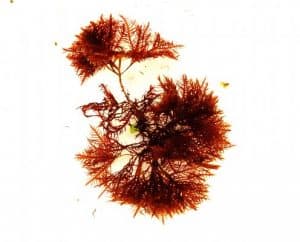
Red Wiry Turf Algae are from the Gelidium genus. Apart from the red wiry turf algae, this genus also accommodates a lot of short but creepy red algae species.
Red wiry turf algae can be hard to remove especially if they come with creep and fragile runners along the rocks. You have to consistently keep trying to get rid of these algae.
How to Get Rid of Red Wiry Turf Algae from Reef Tank?
- To remove the red wiry turf algae from the rocks, you might need to use a dental pick. While you clean the rock with the pick, make sure that the fragments that get loose from the rock are taken out. If you do not do so, they can spread again. It might be boring, but it is an effective solution to fight red wiry turf algae.
- Take the affected rock out of the tank and replace that with a fresh rock.
- Large Turbos, Sea Hares, Emerald Crabs, and Urchins are some of the common algae eaters that work against red wiry turf algae.
11. Blue Green Cyano
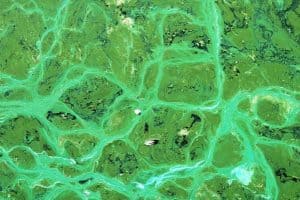
Though they are named as Blue Green Cyano, they appear as dark green. They form a slimy and green mat in the reef tank.
Though you might treat them as regular cyanobacteria species, it is harder to remove them from the tank than cyano. The main reason is that most of the algae eaters are not very interested in them.
Though algae cleaning crews like Limpets, Chitons, and Nerites consume it, they are not able to control the blue green cyano completely.
However, you should not get frustrated if they come back in the tank after a removal process. You might need to treat them after a certain interval as they grow quicker than other types of nuisance algae.
How to Get Rid of Blue Green Cyano from Reef Tank?
- Take mag floats, corals, and rocks to wipe the glass.
- Pull the cyano off from the sand.
- Take out the dislodged cyano from the water by using a siphon or net.
- To starve them out, use a Phosban reactor. You can also take help from granulated ferric oxide (GFO) to remove unnecessary phosphates.
- Do not overfeed the tank inhabitants, especially refrain yourself from feeding phosphate-rich foods. Also, keep them away from immature plankton cultures.
- Cultivate macroalgae like Chaeto and ensure that they get proper light.
- If none of the above-mentioned methods work for you, use good chemical products from trusted brands.
12. Calothrix
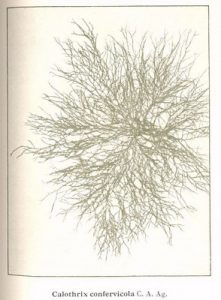
Calothrix is a variation of blue green algae. They are light, slimy, and hairy in appearance. When it comes to the look, Calothrix algae has a lot of similarities to Dinos.
How to Get Rid of Calothrix from Reef Tank?
- Remove the rock to clean it with a toothbrush to bring out the algae. Use a net or siphon to clean out the loose debris.
- Controlling the phosphate level is an effective way to deal with Calothrix. Get a Phosban reactor or cultivate Chaeto to drop the phosphate down.
- If you have a high level of nitrate in the tank, consider adding more live rock or rubble.
- Nerites, Chitons, and other cyano cleaners are quite effective to consume Calothrix from the water.
13. Dictyota
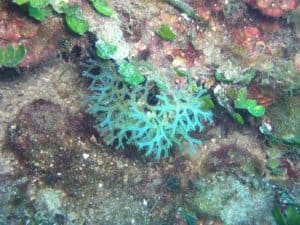
Dictoyota is a kind of brown algae with a blue hue. They are not rigid and come with forked branches. Many of the Dictyota species are microscopic. Some Dictyota species are not harmful to the inhabitants of your reef tank. You can easily remove them out of the tank.
However, nuisance Dictyota species creep along the rock for a shorter period. They do not have any trunk. It is the rock from where the Dictyota branches form. Some Dictyota species are epiphytes and they can grow anywhere including the corals and coral’s base.
However, the growth of Dictyota is easier to control compared to cyano species.
How to Get Rid of Dictyota Algae from Reef Tank?
- Clean every inch of the affected rock with the dental pick.
- Sea Hares, Chitons, Tangs, Limpets, Emerald Crabs, and Urchins consume Dictyota in the reef tank. Longnose Decorator Crabs are the best Dictyota eaters.
- Macroalgae like Chaeto and other species of Caulerpa can compete with these algae and starve them out.
14. Cotton Candy Algae
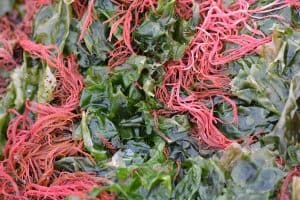
Having a lot of branches along with branchlets, cotton candy algae have an appearance of light pink. They grow mostly out of the water and later on sway in the current. Coming in a small loose form, they look quite good but do not have any aesthetic appeal.
Though cotton candy algae are not so common, they can grow rapidly from the small fragments and then take hold of the tank.
How to Get Rid of Cotton Candy Algae from Reef Tank?
- It is tough to clean cotton candy algae if they get into a place where your fingers can’t reach. If it is possible to get them within your fingers, you can easily scrape the finger thumb on the surface and then remove the algae by holding in a way as you hold a pencil.
- Emerald Crabs, Urchins, Large Turbos, Sea Hares, and Hermit Crabs are very effective algae eaters that love cotton candy algae.
15. Red Bubble Algae
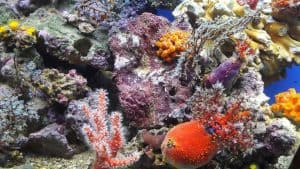
Being one of the Botryocladia species, Red bubble algae may either be invasive or desirable depending on the type.
To differentiate the desirable from the invasive, you have to look at how they grow. While invasive species grow straight on the rocks, the desirable ones grow from the branches.
How to Get Rid of Red Bubble Algae from Reef Tank?
- If you become clumsy in dealing with red bubble algae, the chance is that they will become all-pervasive in the tank. Try to remove them before they get bigger.
- Cover the red bubble algae with any baster and then scrape it along with rock. You will see the bubble coming off. It is time to release the plunger and suck the thing up. Discard and repeat the process until you are done.
- When it comes to manual removal, you should be aggressive so that the invasive red bubble algae do not get the opportunity to come back.
- Small Rabbitfish and Juvenile Mithrax are the best red bubble algae eaters on the planet. However, you can also take assistance from Ruby Mithrax Crabs and Emerald Crabs.
16. Dinoflagellates

With a brownish look, Dinoflagellates are light nuisance algae with trapped air bubbles. They sprout up either from the sand or rock.
However, keep in mind that all the species of Dinoflagellates are not necessarily evil. But, unfortunately, algae eaters are not effective to remove Dinoflagellates from the reef tank.
How to Get Rid of Dinoflagellates from Reef Tank?
- Take the affected rock out and keep it in a big saucepan. Add an adequate amount of water so that the rock goes underwater. Now, boil the water to get the tar out. Rinse it and keep going through scrubbing.
- Repeat the same process once again. Place the rock under the sun to dry for about 3 days.
- Introduce a Phosban reactor.
- Ensure increased skimming.
- Employ macroalgae like Chaetomorpha.
- Some aquarists have got success to get rid of Dinoflagellates by raising the alkalinity and pH. level in the tank. You can also use it. But, do your research before adopting this method and proceed on with caution.
17. Green Wiry Algae
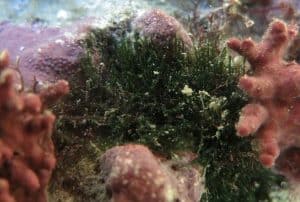
Green Wiry algae generally cling to the rock and create algae bloom from a runner. The branches of Green Wiry Algae are usually short.
Luckily, Green Wiry Algae grow at a slow rate and are not very common. They are different from the green turf algae in the sense that while green turf algae sprout from the rock, green wiry algae just creep along the rock.
How to Get Rid of Green Wiry Algae from Reef Tank?
- It is quite tough to remove the green wiry algae manually. Algae that come with creeps along the rock and have fragile runners, it will be hardest to pluck them out.
- By the way, try to give your best effort to remove them with the dental pick at the very first time you encounter them inside the tank.
- Sea Hares, Emerald Crabs, Turbos, Rock Boring Urchins are some of the clean-up crews you can take assistance from. However, though they consume it, they do not seem to be much interested in green wiry algae.
- If you play nutrient lulls, the chance of winning against these stubborn Green Wiry Algae is not so high. So, manual removing and the clean-up crews are the guns you can make use of to demolish them.
Final Thoughts
By now, you know a lot of ways about how to get rid of algae in a reef tank. Note that different kinds of algae react differently to the actions you take. All of your actions might not work well for all types of algae.
So, follow the ways mentioned above to deal with the specific types of nuisance algae we have talked about. However, always try to start with the manual removing process and employing the algae eaters as they are the safest resorts.
But, if those are of no use, you can adopt the advanced stages like decreasing the nutrients, bringing a balance in alkalinity, magnesium, pH. level, etc., or use a good commercial product from a trusted source.
Always keep in mind that getting rid of algae can be a long-term process and it requires your patience to be successful against the nuisance algae. Just do not lose hope and keep striving.
Happy Reefing!
